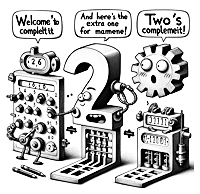Decimal to One's and Two's Complement Binary

Convert decimal numbers into binary representations, focusing on the one's complement and two's complement representations.
One's Complement: For positive decimal numbers, the one's complement is identical to the binary representation of the number. Negative numbers involve flipping all the bits of the positive binary representation.
Two's Complement: For positive decimal numbers, the two's complement is identical to the binary representation of the number. For a negative decimal input it involves adding 1 to the least significant bit of the one's complement
Decimal to One's and Two's Complement Binary Converter
| Enter a decimal number | |||
| Number of Bits: | |||
Results: | |||
|
Calculator
- input the decimal number you want to convert.
- choose the number of bits for the binary representation
Results
- the base 10 number converted to a binary number
- the one's complement binary representations of the decimal number
- the two's complement binary representations of the decimal number
For the decimal number 3, the one's complement and two's complement representations will be 0000 0011.
For the decimal number -3, the one's complement is 1111 1100, and the two's complement representations will be 1111 1101.
For the decimal number -3, the one's complement is 1111 1100, and the two's complement representations will be 1111 1101.
Example Conversion
Convert -15 to one's complement and two's complement binary representations with an 8-bit representation.
Converting to Binary: Decimal input: -15 Binary representation of |15| = 00001111 (8 bits) One's Complement: For one's complement, we flip all the bits of the binary representation. Flipped bits: 11110000 One's complement binary: 11110000 Two's Complement: We add 1 to the one's complement binary representation to get the two's complement. One's complement binary: 11110000 Add 1: 11110000 + 1 = 11110001 Two's complement binary: 11110001 For the decimal number -15 in 8-bit representation:
One's complement binary: 11110000 Two's complement binary: 11110001
Convert 15 to one's complement and two's complement binary representations . (8 bits)
Converting to Binary:
Decimal input: 15 Binary representation: 00001111 (8 bits) Since 15 is a positive number, both the one's complement and two's complement will be the same as the binary representation.
One's Complement:
One's complement binary: 00001111, it's the same as the binary representation for positive numbers
Two's Complement:
Two's complement binary: 00001111, it's the same as the binary representation for positive numbers. The decimal number 15 in 8-bit representation:
One's complement binary: 00001111 Two's complement binary: 00001111
Decimal System (Base-10) Calculators
Base Conversions:
- Decimal to Binary
- Decimal to Octal
- Decimal to One's and Two's Complement Binary
- Decimal to Other Bases
- Decimal to Hexadecimal
- Decimal Fraction to a Hexadecimal Fraction
Fraction and Mixed Number Operations:
- Decimal to Mixed Numbers
- Decimal Fraction to a Proper Fraction
- Fraction Addition
- Mixed Numbers and Fractions Addition
- Mixed Numbers and Fractions Addition - Multiples
- High-Precision Multiple Fraction Addition
- High-Precision Fraction Addition
- High-Precision Fraction Division
- High-Precision Fraction Subtraction
- High-Precision Fractional Exponentiation
- High-Precision Fraction Multiplication
- High-Precision Multiple Fraction Addition
Math Operations:
Number Theory:
- Coprime Checker
- GCD (Greatest Common Divisor)
- LCM (Least Common Multiple)
- Perfect Number
- ---- Prime Factorization
- ---- nth Root for Fractions
- ---- nth Root - Advanced